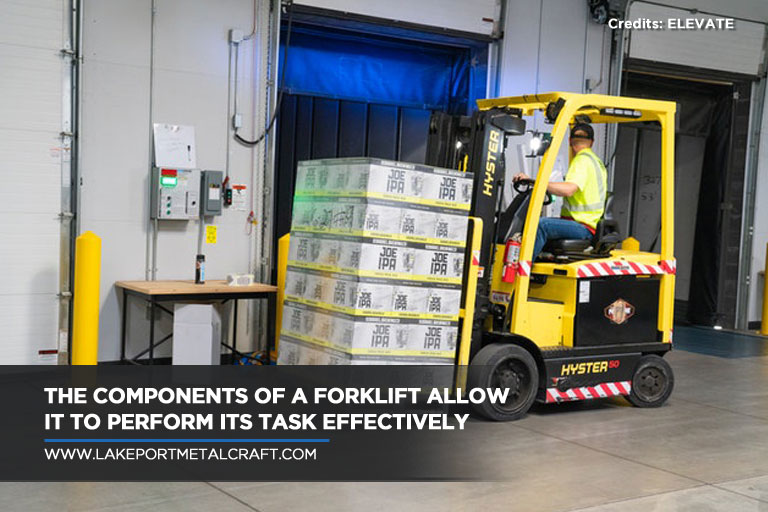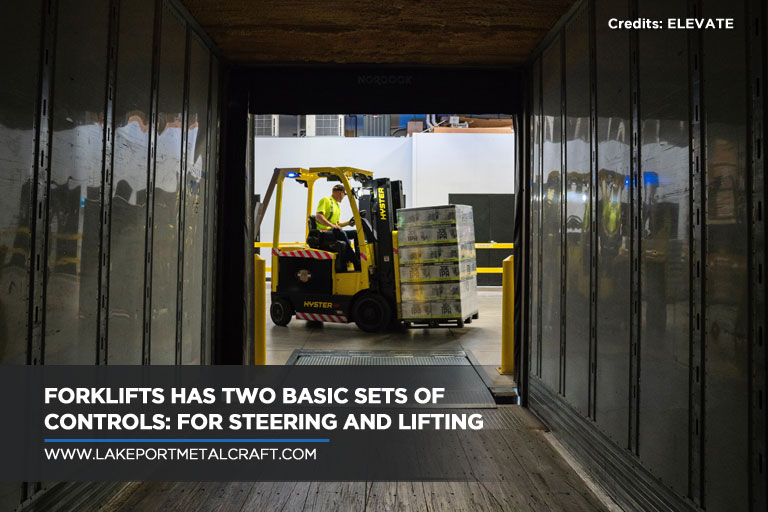A forklift is an industrial vehicle that has a power-operated platform at the front. It has a fork that can be raised/lowered and inserted underneath a cargo for lifting and moving purposes. Forklifts can be powered by combustion engines or electrical batteries.
There are forklift varieties that allow operators to sit when driving the vehicle, while there are others that require the driver to stand (standup forklifts). Forklifts are generally used in the transportation of goods and materials.
Learn more about forklift basics, types, and how using this vehicle can increase efficiency in your daily operations.

What’s In A Forklift
A forklift is made of several component parts that work together to lift, move, and store heavier or bulkier loads efficiently:
- Truck frame – The truck frame makes up the base of the forklift. The truck frame holds the rest of the key parts of the vehicle together, including the wheels, mast, and counterweight.
- Counterweight – This component aims to counter-balance the weight that the vehicle lifts. The counterweight is made of cast iron and is attached to the rear of the forklift.
- Power source – Consisting of a built-in combustion engine, the power source of the forklift can be fueled with diesel, LPG, natural gas, and CNG. Electric-powered forklifts get their power from lead-acid batteries.
- Carriage – Serving as the forklift’s base, the carriage is attached to the mast rails for ease of moving upward and downward.
- Mast – The mast is responsible for lifting and lowering the load. It also has interlocking rails to allow for horizontal controls. The mast can be installed with rollers.

How Forklifts Work
There are two mechanisms that enable forklifts to perform their lifting functions: roller chain pulleys and hydraulic cylinders.
1. Hydraulic cylinders
Found at the base of a forklift is the lift handle which is fixed to an electric-powered air pump. When an operator presses the handle, the air pump is turned on. It then draws the air outside into the filter and pushes it into a tube until it reaches the hydraulic cylinders. The hydraulic cylinder has a hollow tube closed with a flexible, lubricated piston at one end.
The base of the cylinder traps air without leaking it out. As pressure increases in the area of the piston, an upward force is generated, moving the piston up. As this happens, the volume of gas increases and the pressure is minimized. This produces physical equilibrium at the height of the forklift and an amount of force that’s equivalent to the gas and the load of the forklift.
To elevate the load – The forklift operator pushes the handle (forward direction) to signal the forklift to pump excess air into the cylinders.
To lower the load – In a backward direction, the operator pulls the handle to signal a special valve to release gas from the cylinders.
2. Roller chain pulley
The forks that lift and carry loads are fixed to the main body with two roller chain pulleys. The fulcrum of these chain pulleys forms a gear above the mast. As the hydraulic pistons push the mast upwards, the gears at the top of the masts are pressed on the roller chains. This takes place because one side of the chain is attached to the forklift’s solid frame. The masts can only move in an upward direction when the gears rotate clockwise, pulling the forks overhead.
This mechanism is vital, as it allows the forks to move away from the cylinders’ reach. The forklift would need taller cylinders to lift loads to an equal height if not for roller chain pulleys.
Where Forklifts Are Used
Forklift trucks have revolutionized the storage and shipping of goods in various workplaces. Since they were invented in the dawn of the 20th century, forklifts have become the integral machine in industrial workplaces, including:
- Dockyards – Forklifts have been instrumental in unloading and stacking barges and ships way back in the world wars. Today, forklifts are used to move and transport bulky cargos: from delivery trucks to storage regions in the dockside to ships. Forklifts are used particularly in transporting steel and wood shipments.
- Recycling facilities – Besides dockyards, forklifts are also useful in recycling operations. They are used for unloading recycling containers or trucks before their loads are transported to the sorting bays. Forklift trucks are preferred in these operations because they can efficiently load/unload tractor-trailers, elevators, railway cars, and straight trucks.
- Construction sites – Forklifts that are intended for industrial uses also prove useful in construction sites. Construction workers rely on forklifts to carry and transport heavy building materials to certain distances and even on rough terrain. In construction sites, forklifts serve both as lifting equipment and a vehicle. Forklifts are best used in unloading pallets of blocks/bricks, steel joists, and construction equipment and materials, especially in hauling them from the delivery truck and carrying them to the site.
- Warehouses – Forklift trucks are commonly used in warehouse operations as well. They are primarily used to load and unload trucks and transporting goods. There are different types of forklifts available for warehouse use. Each of them varies in size and for the work you will use them for. A forklift’s plate determines the maximum weight it can lift.

Reach Trucks For Warehouse Operations
One of the commonly used forklift types in warehouses is a reach truck. A reach truck is best used for carrying tinned goods and cartons on pallets. A reach truck is a type of lift truck designed for handling unit loads with rack interface. Reach trucks are most functional in warehouses with narrow aisles, and they are commonly used in the retrieval and storage of pallets stacked in racks.
Because they are designed with a pantograph mechanism, reach trucks are instrumental in material handling since they can maximize the capacity of unit loads by promoting product throughput and narrowing the aisles. This lift truck type is intended for racking areas.
Reach trucks are often your best choice, particularly if:
- Your warehouse operations revolve mainly around handling unit loads
- Cube utilization is necessary
- You need to enforce two-way traffic in your facility
- There’s a need to boost productivity in your operations
- Capacity at height has to be maintained

Advantages Of Owning Your Own Reach Truck
Several companies opt to hire a reach truck; but if the majority of your operations require the use of forklifts, it’s often more practical to purchase a truck suited for your particular needs.
The most important reason for owning over renting is familiarity. You can train your employees on a specific machine. This helps them become more competent in using the equipment and be more well-versed with reach truck safety tips when operating the same vehicle in all operations.
Other advantages include not having to wait for a forklift to be delivered, or sourcing reach trucks near you every time that you need one. Your company will also own the machine, which means an additional asset on the ledgers.
When purchasing your reach truck, it is necessary to be clear and specific about your needs. Make sure to prepare these details before asking around for reach truck prices:
- Load capacity (full elevation)
- Top load beam
- Load requirement in terms of weight, dimension, and shape
- Clear ceiling height
- Clear aisle (should be six to 12 inches over minimum aisle is required for right-angle stacking)
- Liftoff space of about eight to 12 inches

Protecting Your Workers
In addition to providing your staff with equipment they need to perform their jobs fast, employers should also protect their staff from potential hazards in the workplace. A common cause of injuries to operators of reach trucks is rearward collisions with racking. This happens because the back of most reach trucks are open, without a physical barrier between the operator and horizontal cross beams.
To protect your operators, install The Backbone® on your reach truck. It is an easy-to-install, ANSI-compliant safety bar that acts as a bumper to keep the operator from being directly hit in case of racking collisions. Increase safety in the workplace and get yours today.
For direct orders or to learn more about The Backbone®, call Lakeport MetalCraft Inc. at 416-587-5809. Ask for Norm Nopper.
